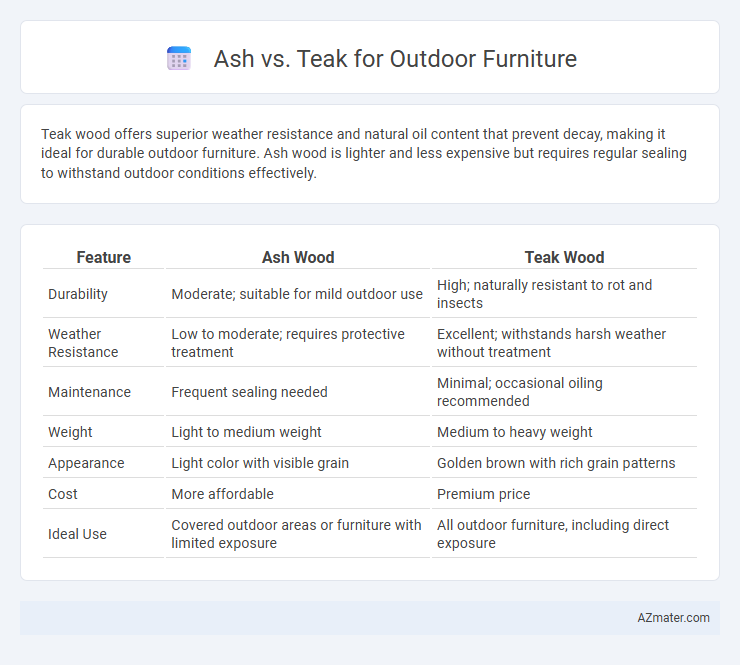Teak wood offers superior weather resistance and natural oil content that prevent decay, making it ideal for durable outdoor furniture. Ash wood is lighter and less expensive but requires regular sealing to withstand outdoor conditions effectively.
Table of Comparison
| Feature | Ash Wood | Teak Wood |
|---|---|---|
| Durability | Moderate; suitable for mild outdoor use | High; naturally resistant to rot and insects |
| Weather Resistance | Low to moderate; requires protective treatment | Excellent; withstands harsh weather without treatment |
| Maintenance | Frequent sealing needed | Minimal; occasional oiling recommended |
| Weight | Light to medium weight | Medium to heavy weight |
| Appearance | Light color with visible grain | Golden brown with rich grain patterns |
| Cost | More affordable | Premium price |
| Ideal Use | Covered outdoor areas or furniture with limited exposure | All outdoor furniture, including direct exposure |
Introduction to Ash and Teak Wood
Ash wood is renowned for its strength, flexibility, and light color, making it a popular choice for durable outdoor furniture that withstands varying weather conditions. Teak wood, prized for its natural oils and dense grain, offers exceptional resistance to moisture, decay, and insects, ensuring longevity and minimal maintenance in outdoor environments. Both woods provide aesthetic appeal and functional benefits, with ash delivering a lighter, more modern look and teak offering rich, warm tones that deepen with age.
Key Characteristics of Ash Wood
Ash wood is prized for its exceptional strength, shock resistance, and straight grain, making it highly durable for outdoor furniture exposed to various weather conditions. Its light color with a smooth texture enables versatile finishes and enhances aesthetic appeal in outdoor settings. The wood's natural resistance to moisture and decay extends the longevity of ash furniture, ensuring reliable performance in garden or patio environments.
Key Characteristics of Teak Wood
Teak wood is renowned for its exceptional durability and natural resistance to water, insects, and decay, making it ideal for outdoor furniture. Its dense grain and high oil content ensure longevity and minimal maintenance, even in harsh weather conditions. Teak's rich golden-brown hue weathers to a beautiful silver-gray patina over time, adding aesthetic appeal to outdoor spaces.
Durability and Weather Resistance Comparison
Ash wood offers moderate durability with good shock resistance but requires regular maintenance to withstand harsh outdoor conditions, as it is prone to moisture absorption and decay. Teak wood excels in durability and weather resistance due to its high natural oil content, which makes it highly resistant to water, rot, and insect damage, ensuring longevity in outdoor furniture. The superior weatherproof qualities of teak reduce the need for frequent sealing or treatments compared to ash, making it a preferred choice for outdoor applications exposed to varying climates.
Maintenance Requirements: Ash vs Teak
Teak wood, known for its high oil content and natural resistance to moisture, algae, and insects, requires minimal maintenance, typically only needing occasional cleaning and oiling to maintain its golden patina. Ash wood, while durable and strong, is more porous and susceptible to weathering, necessitating regular sealing or staining to protect against moisture and UV damage. For outdoor furniture, teak offers superior longevity with less upkeep compared to ash, which demands more frequent maintenance to preserve its appearance and structural integrity.
Aesthetic Differences and Visual Appeal
Ash wood offers a lighter, more uniform grain pattern with a pale, creamy color that brightens outdoor spaces and complements modern, minimalist designs. Teak, renowned for its rich golden-brown hues and natural oil content, develops a distinguished silvery patina over time, enhancing the furniture's rustic and luxurious appeal. The choice between ash and teak for outdoor furniture largely depends on desired visual warmth and the weathering effect preferred in outdoor aesthetics.
Environmental Impact and Sustainability
Ash wood is a renewable resource with a faster growth rate than teak, making it a more sustainable option for outdoor furniture due to its lower environmental impact. Teak's natural oils provide exceptional durability and resistance to weather, but its slow growth and overharvesting contribute to deforestation and ecological imbalance. Choosing ash helps reduce carbon footprint and supports sustainable forestry practices, while teak demands careful sourcing from certified plantations to minimize environmental harm.
Price and Affordability Analysis
Ash outdoor furniture generally offers a more affordable price point compared to teak, making it an excellent choice for budget-conscious consumers seeking durability and aesthetic appeal. While teak commands a premium due to its natural oils, resistance to rot, and long lifespan, ash provides a cost-effective alternative with decent weather resistance when properly treated. Choosing ash can significantly reduce initial investment costs without compromising too much on performance for outdoor settings.
Best Applications for Ash and Teak Outdoors
Ash wood offers exceptional strength and flexibility, making it ideal for outdoor furniture that requires durability and shock resistance, such as benches and chairs exposed to high use. Teak's natural oils and high silica content provide superior water resistance and longevity, perfect for outdoor dining sets and loungers placed in humid or rainy climates. Both woods excel outdoors but ash is best suited for structural pieces needing resilience, while teak thrives in environments demanding weatherproofing and low maintenance.
Conclusion: Making the Right Choice for Outdoor Furniture
Ash offers a lighter appearance and greater flexibility, making it suitable for contemporary outdoor furniture designs, while teak provides unparalleled durability and natural resistance to weather elements, ensuring long-term performance. Teak's high oil content makes it highly resistant to moisture, insects, and decay, making it a premium choice for outdoor environments. Choosing between ash and teak depends on desired aesthetics, maintenance preferences, and budget, with teak favored for longevity and ash for cost-effective style.

Infographic: Ash vs Teak for Outdoor Furniture
 azmater.com
azmater.com